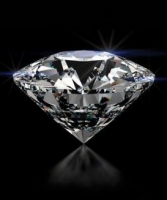








Synthetic diamond is diamond produced in an artificial process, as opposed to natural diamonds, which are created by geological processes. Synthetic diamond is also widely known as HPHT diamond or CVD diamond after the two common production methods (referring to the high-pressure high-temperature and chemical vapor deposition crystal formation methods, respectively). While the term synthetic is associated by consumers with imitation products, artificial diamonds are made of the same material (pure carbon, crystallized in isotropic 3D form).In the U.S., the Federal Trade Commission has indicated that the alternative terms laboratory-grown, laboratory-created, and [manufacturer-name]-created "would more clearly communicate the nature of the stone".
Invention History
Tracy Hall produced synthetic diamond in a press of his own design on December 16, 1954 and that he and others could do it over and over in the following week and that success led to the creation of a major super materials industry. What is also undoubted is that Hall was one of a group of about a half dozen of researchers who had focused on the syntheses for almost four years. These years had seen a succession of failed experiments, an increasingly impatient management, and a complex blend of sharing and rivalries among the researchers.
Hall's success, in his telling of the story, came about because of his determination to go his own way with a radical redesign of the press, which employed a doughnut-shaped binding ring (the belt) which confined the sample chamber and two curved and tapered pistons which pressed on the sample chamber. He "bootlegged" the machining of the first hardened steel version of this press, which showed some promise, and eventually got management to approve the construction of it in the tougher, much more expensive Carboloy (tungsten carbide dispersed in cobalt, also known as Widia). However, his experiments were "relegated" (Hall claimed) to a smaller, antique, leaky 400 ton press, rather than a more expensive and new thousand ton press used by other members of the team.
The composition of the starting material in the sample chamber, catalyst for the reaction, and the required temperature and pressure were little more than guesses. Hall used iron sulfide and a form of powdered carbon as the starting material, with tantalum disks to conduct the electricity into the cell for heating it. The experiment was conducted at about 100,000 atmospheres, 1600 °C and took about 38 minutes.Upon breaking open the sample, clusters of diamond octahedral crystals were found on the tantalum metal disks, which apparently acted as a catalyst.
GE went on to make a fortune with Hall's invention. GE rewarded Hall with a $10 Savings Bond, in addition to his regular salary.